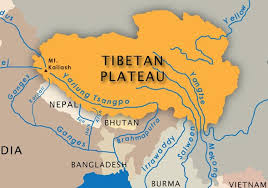Over the last 15 years we have heard a great deal about the importance of ‘Global Warming’ (the increase in global temperatures due to the accelerated emission of greenhouse gases) but little international attention has been given to its effect on Tibet and that is very surprising since what happens in Tibet will have dramatic repercussions, not only for S.E Asia but for the rest of the world as well.
Tibet is home to the Hindu Kush Himalayan ice sheet – an area covering over one thousand square kilometres and comprising more than 46 thousand glaciers making it the largest ice reservoir in the world after the north and south poles – which is why it is often called ‘The Third Pole’. Global warming is resulting in a shrinking of the glaciers as the ice is melting much faster than the global average and it is expected that sixty percent of Tibet’s glaciers will have disappeared entirely by 2050. These are shocking statistics.
The Permafrost – perennially frozen ground – is also melting at a faster rate than anywhere else on earth and this thawing of both glaciers and permafrost together with changing rainfall patterns is leading to a dramatic alteration in the geography of the country. Tibet now has 14 percent more lakes than it did in 1970, and more than 80 percent of existing lakes have expanded, flooding surrounding pastures and rural communities. Ironically, because this flooding is uneven and unpredictable many pre-existing lakes have dried up completely and several large wetland areas have become deserts.Melting permafrost results in soil erosion and mudslides and its effects have already been seen; for example, in 2004 rapid landslides and flooding of the Yi’ong river destroyed highways, bridges and hundreds of Tibetan homes. The impact on the lives of the local communities and the economy of the region has therefore been dramatic.
It is important to understand that it is not just Tibet that is suffering though. The Tibetan glaciers act as the source for 10 of the largest rivers in Asia supplying fresh water to 1.3 billion people – nearly one third of the world’s population – living in Bangladesh, Bhutan, Burma (Mynamar), Cambodia, China, India, Laos, Nepal, Pakistan, Thailand and Vietnam. As the glaciers melt, these rivers flood, resulting in landslides, soil degradation and erosion, loss of fish stocks and an increase in water borne diseases. These short term effects are serious enough but the longer term effects are more so because as the glaciers disappear and rivers dry up, all the downstream countries will suffer from desertification and drought on an unimaginable scale.
Equally as worrying in the global context, the melting permafrost is of special concern because the permafrost contains almost twice as much carbon as the atmosphere from all the organic matter frozen within it. As it melts greenhouse gases (Carbon Dioxide and Methane) are released on such a scale that global warming effects are greatly amplified causing even faster permafrost melting. This has been called the ‘permafrost carbon feedback’ and it is, unfortunately, irreversible.
His Holiness, the Dalai Lama has expressed his own concern about the disappearance of Tibet’s glaciers and has called for special attention to be paid to Tibet’s ecology. While several states in the area are developing strategies to mitigate the impact of the melting Tibetan ice, there are, as yet, no multilateral agreements encompassing all the countries affected. However, the recent agreement between USA and China (the biggest carbon polluters in the world) to reduce carbon emissions, if fully implemented, is a ray of hope and a promising start to the conference of world leaders, planned for December 2015, to finalise a global agreement on carbon reduction. Let us hope that, this time, sense will prevail and our Governments will consider the global environmental needs above their own countries’ economic and political ones.
*This article was written for Tibet Nature and originally published on www.tibetnature.net






 Print
Print Email
Email